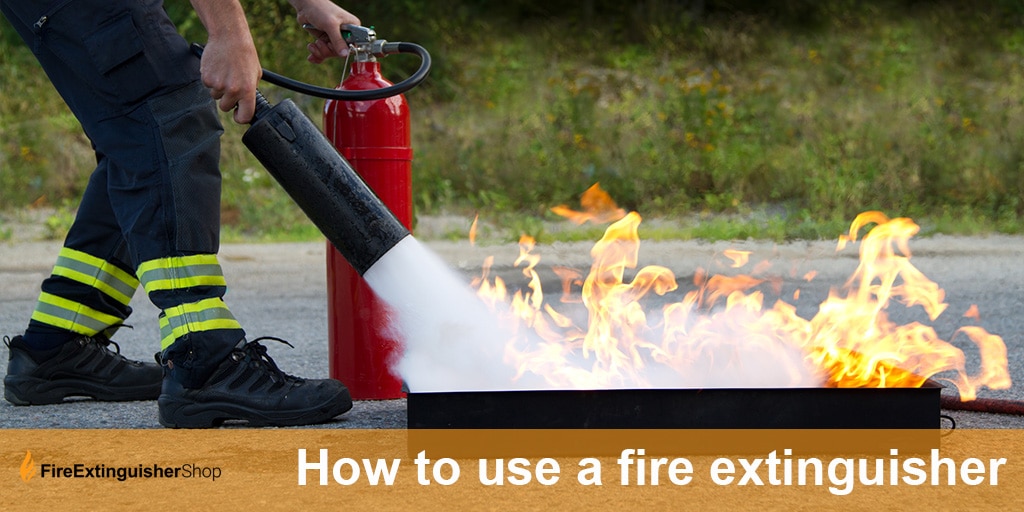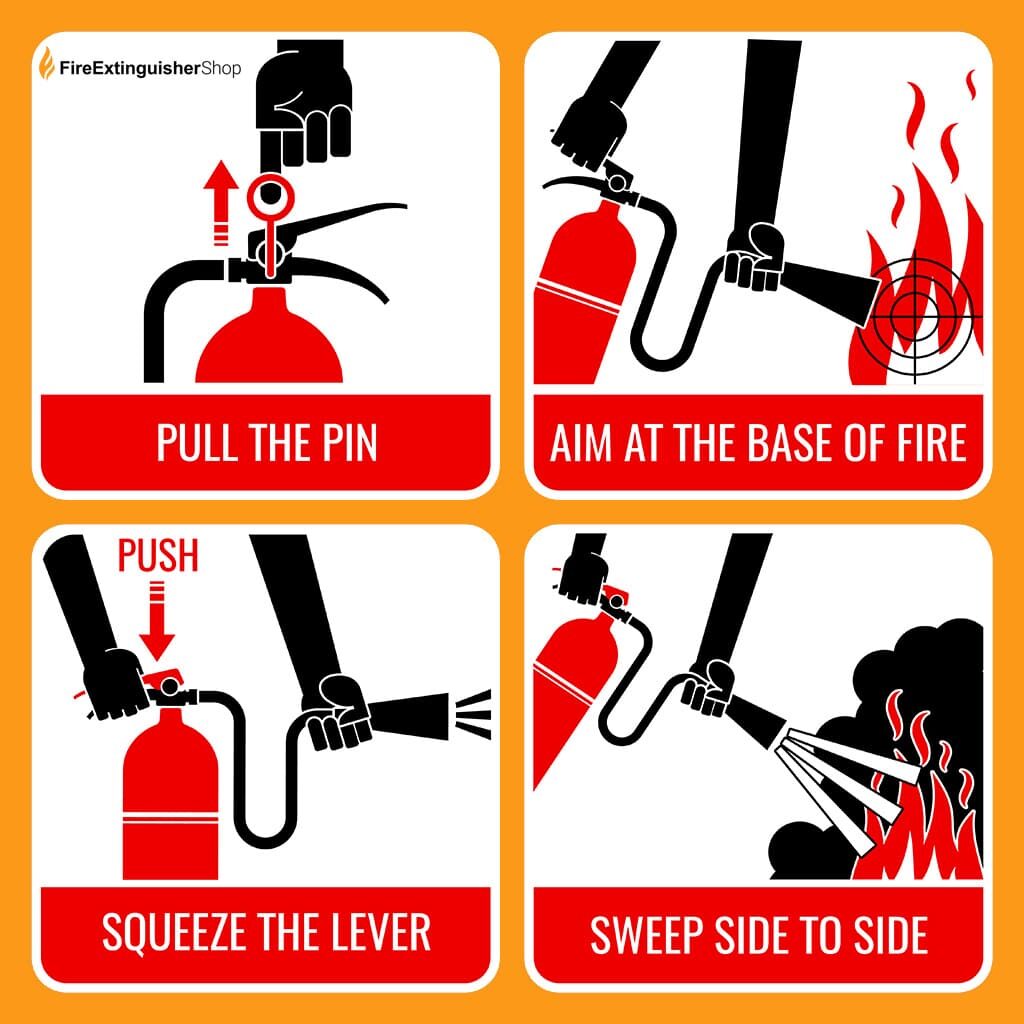How To Use A Fire Extinguisher
When a fire starts in your home or business, you have mere seconds to act. Your best line of defence is a using the correct fire extinguisher. However, a lack of maintenance or improper use of the fire extinguisher could endanger your life and put your property at risk of serious damage.
With the right fire extinguisher and the knowledge of how to correctly use it, you can put out a fire or buy enough time to safely evacuate before emergency fire services personnel arrive on the scene. Here’s what you need to know about proper use of a fire extinguisher.

Identify The Type Of Fire Extinguisher
Identify each of the fire extinguishers in your home or business. There are different types of portable fire extinguishers, and some are rated only for certain purposes. For example, a fire extinguisher that uses water should never be used on a grease or electrical fire. Each fire extinguisher has a label that indicates its contents. These labels are color-coded to show which fires they can safely extinguish. You need to know:
- What is the type of the fire extinguisher?
- What is the size of the fire extinguisher.
- What classes of fire can extinguisher be used on?
- What materials are included in each of these fire classes?
- Is the pressure indicator showing the right level of charge?
- Has the fire extinguisher been tested every 6 months by a professional?
- Is the date of manufacture or the last pressure test within 5 years?
How To Operate A Fire Extinguisher
All portable fire extinguishers use the PASS system for operation. PASS stands for Pull, Aim, Squeeze and Sweep. These four steps are all you need to know to operate a fire extinguisher.
Pull The Pin
Locate the pin on top of the fire extinguisher. In the case of a fire, pull it. This will break its seal. When the pin is in place, it prevents the handle from activating the extinguisher. You can test the fire extinguisher by pulling the pin and pressing the handle. Aim it away from yourself. This allows you to determine if the device works and how far the stream of fire-retardant travels. If a fire does erupt, you’ll know how far away from it you can be and still reach it with the stream.
Aim The Nozzle
Approach the fire while remaining at a safe distance. Aim the outlet or nozzle at the base of the fire.
Squeeze The Handle
Squeeze the fire extinguisher handles together. This discharges the agent that extinguishes the fire. Use full pressure to completely depress the fire extinguishers handles. To stop discharging the extinguishing agent, slowly let go of the handles.
Sweep the Nozzle
As you approach the fire, sweep the nozzle from side to side at the base of the flames. After you extinguish a Class A fire, look for hot spots or smouldering debris that could reignite. Apply additional extinguishing agent to those areas.

When to Use a Fire Extinguisher
Only use a fire extinguisher if the flames are shorter than you and the fire is contained. If the fire is growing or the flames are taller than you, don’t attempt to put it out with an extinguisher.
Recognize the Types of Fires
Although you don’t need to be a fire expert, becoming familiar with the types of fires and the types of fire extinguishers to use on them will help you maintain safety. There are six classes of fire, and they each have a letter designation.
Class A
These fires consist of combustible materials, including flammable solid. Examples of Class A fires include burning wood, paper, plastic, and fabric.
Class B
Class B fires start from flammable liquids, such as gasoline or diesel fuel, turpentine, or paint.
Class C
Class C fires ignite from flammable gases, including hydrogen, butane, and methane.
Class D
Class D fires result from the ignition of combustible metals, such as magnesium, aluminium or potassium.
Class E
These are electrical fires. Once an electrical item is removed, the fire class changes.
Types of Fire Extinguishers
Your home or business may have more than one type of fire extinguisher. The different types are designed to extinguish different fires. Each type has subtle differences in how they should be used to completely extinguish the flames.
Water Fire Extinguisher
Only use a water extinguisher on a Class A fire. Never use them on any other type of fire. Water extinguishers have a red cylinder and red band.
Dry Chemical Powder Fire Extinguisher
A dry chemical powder extinguisher creates a barrier between oxygen and the fuel of the fire. Use this type on Class A, B and E fires. These extinguishers have a red cylinder and white band at the top of the tank.
Carbon Dioxide Fire Extinguisher
A carbon dioxide extinguisher takes away oxygen and reduces heat. It works on Class A, B and E fires. It features a red cylinder and black band around the tank’s top.
Foam Fire Extinguisher
Foam extinguishers cut off a fire’s oxygen supply. They work best on Class B fires and some Class A fires. They have a red cylinder and a blue band.
Wet Chemical Fire Extinguisher
A wet chemical fire extinguisher removes heat, creates a barrier to oxygen and prevents re-ignition. Use it on Class F and Class A commercial kitchen fires. Wet chemical extinguishers feature a red cylinder and yellow band at the top.
Make Sure All Occupants Know How to Use the Extinguisher
Everyone who lives in your home or works in your business must know how to use the fire extinguisher. If only one person is familiar with the device’s use, and they’re not available when a fire starts, everyone’s lives could be in danger. If you replace your fire extinguishers with a new model or brand, take the time to retrain everyone on how to use them. It’s good practice to test the fire extinguishers once per year and to have everyone go through the steps of using them.
Why You Must React Quickly
You have just a second or two to decide about whether you can extinguish the fire. If you don’t think you can put it out, it’s best to evacuate the building and call for emergency fire services. A fire doubles in size every 60 seconds. If you’re trying to find the extinguisher or figure out how to use it, you’re wasting precious time. Trying to sort out an instruction manual while a grease fire grows on your stove top could put you in the middle of an inferno in just two or three minutes. Our goal is to ensure that you’re prepared if a fire ignites in your home or business. A well-maintained fire extinguisher that you know how to use is your key to safety. For more information about correct use of fire extinguishers, reach out to us today.
